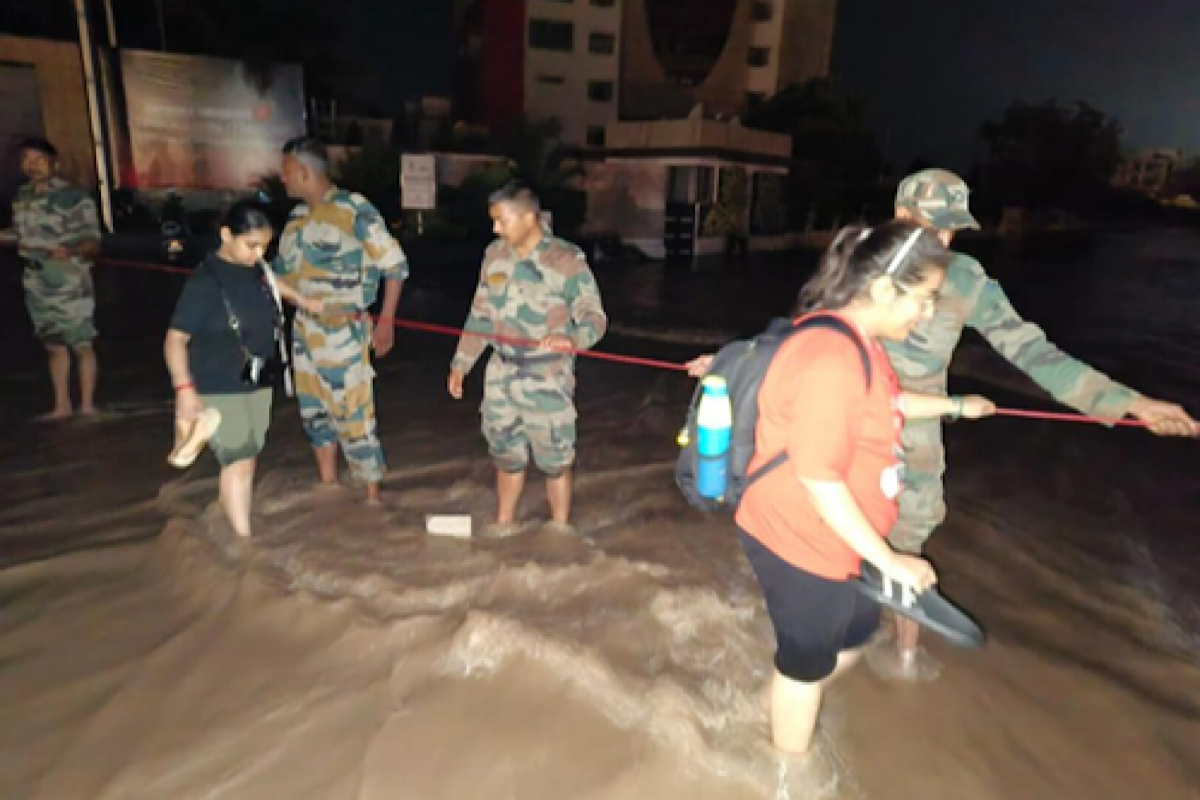In a devastating turn of events, heavy rainfall has engulfed several parts of northern India, leaving the region drowned and claiming the lives of at least 19 individuals in the past 72 hours.
Cities and towns are currently grappling with the aftermath as roads and buildings remain submerged in knee-deep water, causing widespread chaos and disruption. Authorities are struggling to cope with the overwhelming situation, and the local populace is facing severe hardships.
Advertisement
The meteorological department has issued a forecast, predicting further downpour across various states in the region. Himachal Pradesh, Uttarakhand, Punjab, Haryana, Jammu and Kashmir, Rajasthan, Delhi, and the adjoining areas are anticipated to witness continued rainfall in the coming days.
On Sunday, India experienced an alarming 81% above-normal rainfall, with Delhi registering the highest precipitation in the past four decades. The intensity of the deluge was unprecedented, leaving the region astounded and ill-prepared for the consequences.
According to the weather department, Himachal Pradesh faced an onslaught of 104 mm rainfall on Sunday, a staggering thirteen times higher than the normal levels. Similarly, Delhi, Chandigarh, Haryana, Jammu and Kashmir witnessed rainfall nine times above the average, while Punjab encountered rainfall exceeding twelve times the usual figures.
The heavy downpours led to the loss of five lives in Himachal Pradesh alone. Landslides and flash floods wreaked havoc, causing substantial damage to houses and disrupting the normal course of life. As a precautionary measure, authorities have ordered the closure of schools and colleges for two days.
The situation is further aggravated by the swelling of major rivers in the region. Officials have declared a state of emergency, revealing that all major rivers are currently in spate. A fresh red alert has been issued, warning of extremely heavy rainfall (above 204 mm) in ten out of twelve districts, excluding the tribal districts of Kinnaur and Lahaul and Spiti, on July 9.
14 major landslides and thirteen flash floods were reported within the past 36 hours, causing significant disruption to the region’s transportation infrastructure. More than 700 roads have been closed, impeding the movement of vehicles and isolating communities.
As a safety measure, the government of Himachal Pradesh has decided to shut down all government and private schools and colleges affiliated with the state for two days, commencing on July 10.
The consequences of the heavy rainfall have been felt beyond Himachal Pradesh. Uttarakhand experienced a landslide near Chhinka, leading to the closure of the Badrinath National Highway. Similarly, NH-9 in the Kumaon division at Champawat had to be shut down due to adverse weather conditions.
In the Tehri district, a tragic incident occurred as a vehicle rolled downhill in Gular, resulting in the rescue of only five out of the eleven passengers. A search operation is currently underway to locate the remaining six individuals.
With the Indian Meteorological Department issuing a red alert for Sunday, Chief Minister Pushkar Singh Dhami has directed all state officials to remain vigilant in light of the impending heavy rainfall. The situation remains critical, and authorities are on high alert to respond to any emergencies.
Haryana has also been significantly affected by the heavy rains. The Yamuna River has breached the danger mark of 70,000 cusecs, with measurements reaching 84,000 cusecs at the Hathnikund Barrage in Haryana. Officials fear that the water flow may escalate further as heavy rainfall continues in the hills. The region is grappling with flood-like conditions, and extensive farmland, including acres of paddy, sugarcane, and vegetable cultivation, has been submerged. The state agriculture department is currently assessing the damage caused to crops.
Punjab, Haryana, and Chandigarh are under an orange alert issued by the meteorological department, signaling the potential for significant rainfall in the region. Chandigarh experienced an astonishing downpour of 322 mm within a mere 24 hours, shattering all previous records. The average monthly rainfall for July in the tri-city area is typically around 275 mm, making this extreme rainfall event particularly unprecedented.
The India Meteorological Department (IMD) has anticipated further rainfall in the coming days. The prevailing weather conditions are attributed to a low-pressure area developing over the Bay of Bengal, which is expected to intensify into a depression over the next few days. The active monsoon trough is also expected to strengthen and extend up to the foothills of the Himalayas.
As for the immediate forecast, the weather department has predicted a generally cloudy sky with moderate rain throughout the day in Delhi. The city recorded a minimum temperature of 25 degrees Celsius, three notches below the seasonal average.
The situation in north India remains critical as the region grapples with the aftermath of relentless rainfall. Authorities are working tirelessly to mitigate the impact and provide relief to affected communities.











